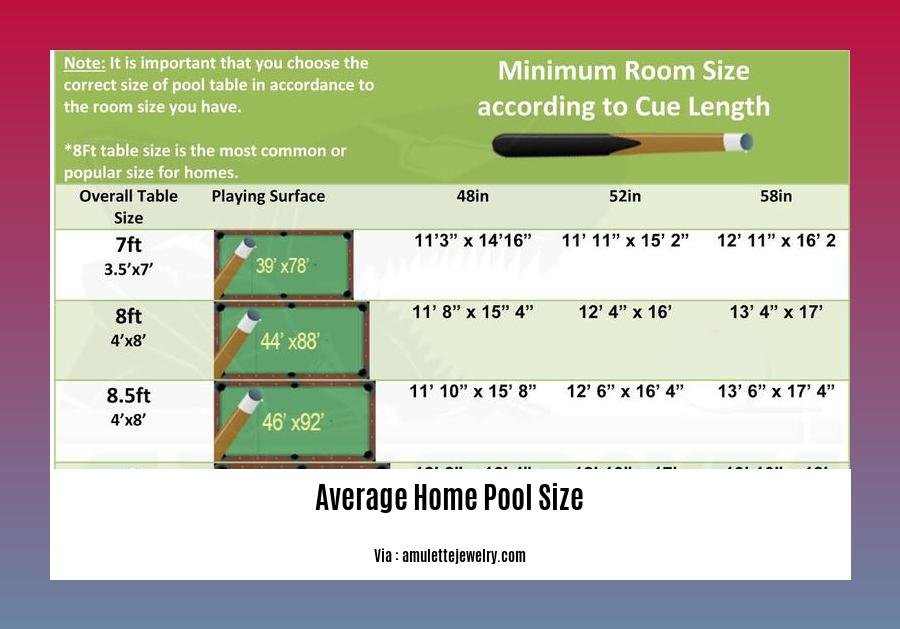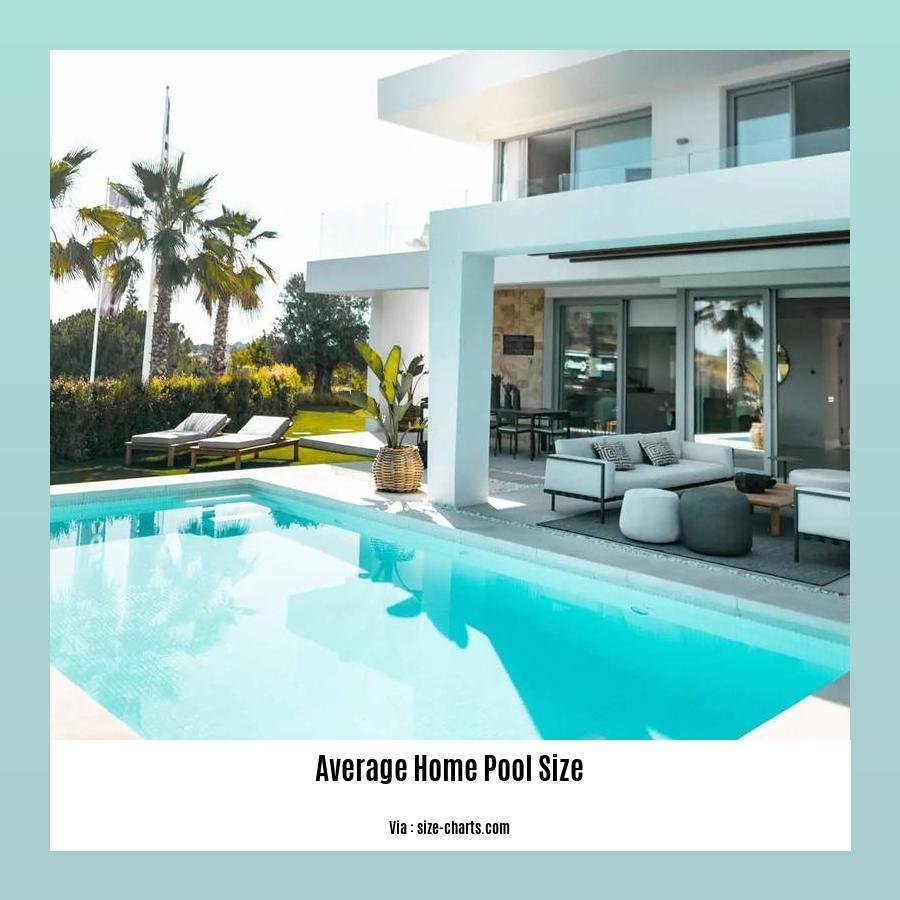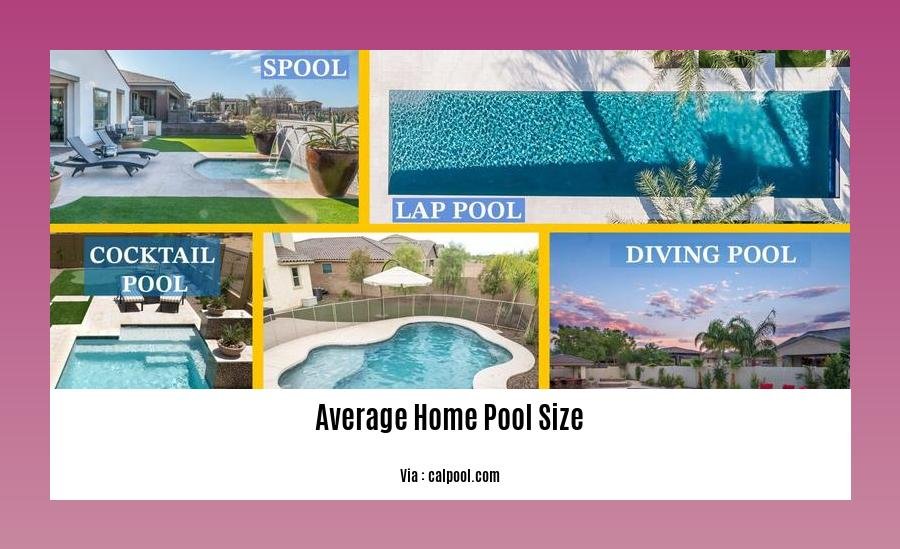Welcome to the comprehensive guide to pool dimensions, your ultimate resource for understanding average home pool sizes. Whether you’re a homeowner dreaming of your own backyard oasis or a professional seeking expert insights, this article will provide you with all the essential information you need to make informed decisions about pool size, shape, and design. Get ready to dive into the world of home pool dimensions and discover the perfect pool size for your needs and preferences.
Key Takeaways:
- The average home pool is approximately 600 square feet in area.
- Common inground pool dimensions range from 10 x 20 feet to 20 x 40 feet, with depths between 3 and 6 feet.
- The most popular rectangular pool size is 16 x 32 feet.
- Some pools are measured in meters instead of feet, such as 6 x 3 meters or 7 x 3 meters.
Average Home Pool Size: Know Before You Jump In

So, you’re thinking about installing a pool in your backyard? Congratulations! A home pool can bring endless joy and memories for you and your loved ones. But before you dive in, it’s essential to consider the average home pool size.
What is the Average Home Pool Size?
The average home pool size in the United States is roughly 600 square feet. This translates to a rectangular pool measuring 16 x 32 feet, with a depth ranging from 3 to 6 feet. Of course, this is just an average—the actual size of your pool will depend on your needs, budget, and available space.
Factors to Consider When Choosing a Pool Size
When selecting a pool size, several factors need to be considered:
-
Available Space: Measure your backyard carefully to determine the maximum pool size that will fit. Ensure you leave enough room for decking, landscaping, and other features.
-
Budget: Pool installation and maintenance can be costly, so it’s essential to set a realistic budget before you start shopping.
-
Pool Usage: Consider how you and your family will use the pool. If you’re planning on swimming laps, you’ll need a longer pool. If you prefer lounging and playing, a smaller pool might suffice.
-
Safety: If you have young children, you’ll need to choose a pool with safety features like a fence, alarm, or pool cover.
Benefits of Having a Pool
There are many benefits to having a pool in your backyard:
-
Exercise and Recreation: Swimming is a great way to get exercise and stay active. A pool also provides a fun and refreshing way to cool off on hot summer days.
-
Entertainment: A pool can be a great place to entertain guests. You can host pool parties, barbecues, and other gatherings.
-
Relaxation: A pool can be a great place to relax and de-stress. Taking a dip in the pool can help you unwind after a long day or week.
Conclusion
Choosing the right pool size for your home is an important decision. By considering the factors discussed above, you can select a pool that meets your needs and budget. With a little planning, you can create a backyard oasis that you and your family will enjoy for years to come.
If you are preparing for an upcoming alumni homecoming speech, check out our exclusive samples to ensure your address is engaging and memorable.
Curious about how home loan interest rates have trended over the past decade in Australia? Dive into our comprehensive analysis to stay informed.
Before finalizing your backyard oasis, explore our guide to average home swimming pool sizes to ensure your pool matches your needs and the available space.
Benefits and considerations of having a pool of the average size
Whether you’re a seasoned pool owner or contemplating taking the plunge, understanding the pros and cons of having a pool of average size can help you make an informed decision. So, let’s dive in!
Benefits of an Average-Sized Pool
-
Affordability: Compared to larger pools, average-sized pools are more budget-friendly, making them accessible to a wider range of homeowners.
-
Less Maintenance: With a smaller surface area, average-sized pools require less cleaning, chemical treatment, and overall maintenance, saving you time and money.
-
Energy Efficiency: Smaller pools require less energy to heat and cool, resulting in lower utility bills.
-
Easier Installation: The installation process for an average-sized pool is often less complex and time-consuming, ensuring a quicker transition from construction to enjoyment.
-
Versatile Usage: An average-sized pool provides ample space for swimming, playing water games, and relaxing without feeling cramped.
Considerations Before Installing an Average-Sized Pool
-
Limited Space: If your backyard is on the smaller side, an average-sized pool may dominate the available space, leaving little room for other outdoor activities.
-
Limited Activities: For those who desire a pool for intensive swimming workouts or hosting large pool parties, an average-sized pool may feel restrictive.
-
Safety: It’s crucial to implement proper safety measures, such as fencing and alarms, to minimize the risk of accidents, especially if you have young children or pets.
-
Long-Term Maintenance: While an average-sized pool requires less maintenance than larger pools, it still demands regular cleaning, chemical balancing, and equipment upkeep.
Key Takeaways:
- Average-sized pools offer affordability, reduced maintenance, and energy efficiency.
- They provide a good balance of space for various activities without overwhelming smaller backyards.
- Safety measures are essential for preventing accidents and ensuring peace of mind.
- Regular maintenance is necessary to keep the pool clean and functioning optimally.
Sources:
- Poolonomics: Pool Sizes: Why Size Actually Matters
- Size Charts: Pool Size Chart – What are the Standard Pool Sizes by Shape
Comparison of the average home pool size to other types of pools

Home pools come in various sizes and shapes to accommodate individual preferences and backyard spaces. Understanding these differences can guide future homeowners or pool enthusiasts in making informed decisions.
Key Takeaways:
-
Average Home Pool Size: Typical home pools in the United States measure around 600 square feet, usually rectangular and around 16 x 32 feet.
-
Lap Pools: Designed for exercise, lap pools have longer, narrower dimensions, allowing for consistent swimming workouts.
-
Above Ground Pools: Unlike inground pools, above-ground pools are easier to install and don’t require extensive excavation.
-
Plunge Pools: These compact pools are deeper than traditional models and focus on cooling off and relaxation rather than swimming laps.
-
Consideration Factors: Beyond size, crucial considerations include available outdoor space, budget, swimming preferences, and desired pool activities.
Comparing Home Pool Sizes to Other Types
| Pool Type | Average Size | Typical Features |
|---|---|---|
| Home Pools | 16 x 32 feet; 600 square feet | Versatile for various activities like swimming, playing, and entertaining |
| Lap Pools | 8 x 52 feet or 10 x 40 feet | Narrow and long for uninterrupted swimming laps |
| Above Ground Pools | 15 x 30 feet | Easily installed and removed, suitable for temporary or smaller spaces |
| Plunge Pools | 8 x 8 feet or 10 x 10 feet | Compact and deep for relaxation and cooling off, often with jets or waterfalls |
Choosing the Right Pool Size
Selecting the ideal pool size involves careful consideration of several factors:
-
Available Space: Measure your backyard to determine the maximum size that fits harmoniously.
-
Activities: Think about how you envision using the pool, whether for swimming, playing games, or entertaining.
-
Budget: Pools vary in cost based on size, shape, and features. Set a realistic budget and stick to it.
-
Safety: If you have young children, prioritize safety features like fences, alarms, and pool covers.
Conclusion
Ultimately, selecting the right pool size is a personal choice that aligns with your outdoor space, budget, and desired activities. Explore various pool types, compare their average sizes, and consider the unique characteristics of each to find the ideal match for your backyard oasis.
Citations
- Swimming Pool Dimensions – SwimOutlet.com
- Average Pool Size Explained by Type of Pool – Size-Charts.com
Safety and maintenance considerations for the average home pool size
If you’re thinking about installing a pool in your backyard, there are a few things you need to consider to ensure the safety of your family and friends. Most importantly, you need to make sure the pool is the right size for your yard and your budget.
Determining the Right Pool Size
The average home pool size in the United States is 600 square feet, but the size of your pool will depend on a number of factors, including:
- The size of your backyard: You need to make sure the pool is big enough to accommodate your needs, but it also needs to be small enough to fit in your yard.
- Your budget: In-ground pools can cost anywhere from $20,000 to $100,000, so you need to make sure you have the money to cover the cost of installation and maintenance.
- The way you plan to use the pool: If you just want a place to cool off on hot summer days, a smaller pool will suffice. But if you want to be able to swim laps or play pool games, you’ll need a larger pool.
Safety Considerations
Once you’ve decided on the size of your pool, you need to consider the safety of your family and friends. Here are a few things you can do to make sure your pool is safe:
- Install a fence around the pool: This is the most important thing you can do to prevent accidental drowning. The fence should be at least 4 feet high and have a self-closing gate.
- Get a pool alarm: This will alert you if someone falls into the pool.
- Keep the pool water clean and clear: This will help to prevent the spread of bacteria and algae.
- Educate your family and friends about pool safety: Make sure they know the rules of the pool and how to swim safely.
Maintenance Considerations
In addition to safety, you also need to consider the maintenance of your pool. Here are a few things you’ll need to do to keep your pool in good condition:
- Clean the pool regularly: This includes skimming the surface of the water, vacuuming the bottom, and brushing the walls.
- Check the pool’s pH balance: The pH balance should be between 7.2 and 7.8.
- Add chemicals to the pool: This will help to keep the water clean and clear.
- Cover the pool when it’s not in use: This will help to keep the pool clean and prevent evaporation.
Key Takeaways:
- The average home pool size in the United States is 600 square feet.
- When choosing a pool size, consider the size of your backyard, your budget, and how you plan to use the pool.
- To ensure the safety of your family and friends, install a fence around the pool, get a pool alarm, keep the pool water clean and clear, and educate your family and friends about pool safety.
- To keep your pool in good condition, clean the pool regularly, check the pool’s pH balance, add chemicals to the pool, and cover the pool when it’s not in use.
Citation:
– Home Pool Safety Guidelines from StaySafe.org
– Pool Safety Checklist from the Pool Safety Foundation
FAQ
Q1: What are the typical dimensions of an average home swimming pool?
A1: The average size home swimming pool typically ranges from 10 x 20 feet to 20 x 40 feet, with a depth of 3 to 6 feet. The most popular rectangular pool size is 16 x 32 feet.
Q2: What are the factors to consider when choosing a pool size?
A2: When choosing a pool size, consider the purpose of the pool (recreation, exercise, or both), available space, budget, and safety considerations such as fencing and alarms.
Q3: What safety measures should be taken around a home pool?
A3: To ensure pool safety, install a fence around the pool, secure pool covers, maintain the pool water, provide emergency equipment like life jackets and first aid kits, and educate family members and guests about pool safety rules.
Q4: How can I determine the maximum feasible pool size for my backyard?
A4: Measure the available backyard space to determine the maximum pool size while maintaining adequate safety clearances. Consider the location of the pool in relation to the house, landscaping, and other structures.
Q5: What are the ongoing maintenance costs associated with a home pool?
A5: Ongoing maintenance costs for a home pool include pool cleaning and chemicals, electricity for pumps and filters, repairs, and regular inspections. The cost can vary depending on the pool size, type, and local climate.
- Doubling 1/3 Cup: Quick Answer and Easy Kitchen Conversions - March 22, 2025
- J Middleton Unit (Abilene, TX): Inmate Search, Visitation, and Contact Information - March 22, 2025
- Ivermectin Dosage for Dogs: A Weight-Based Guide - March 22, 2025










